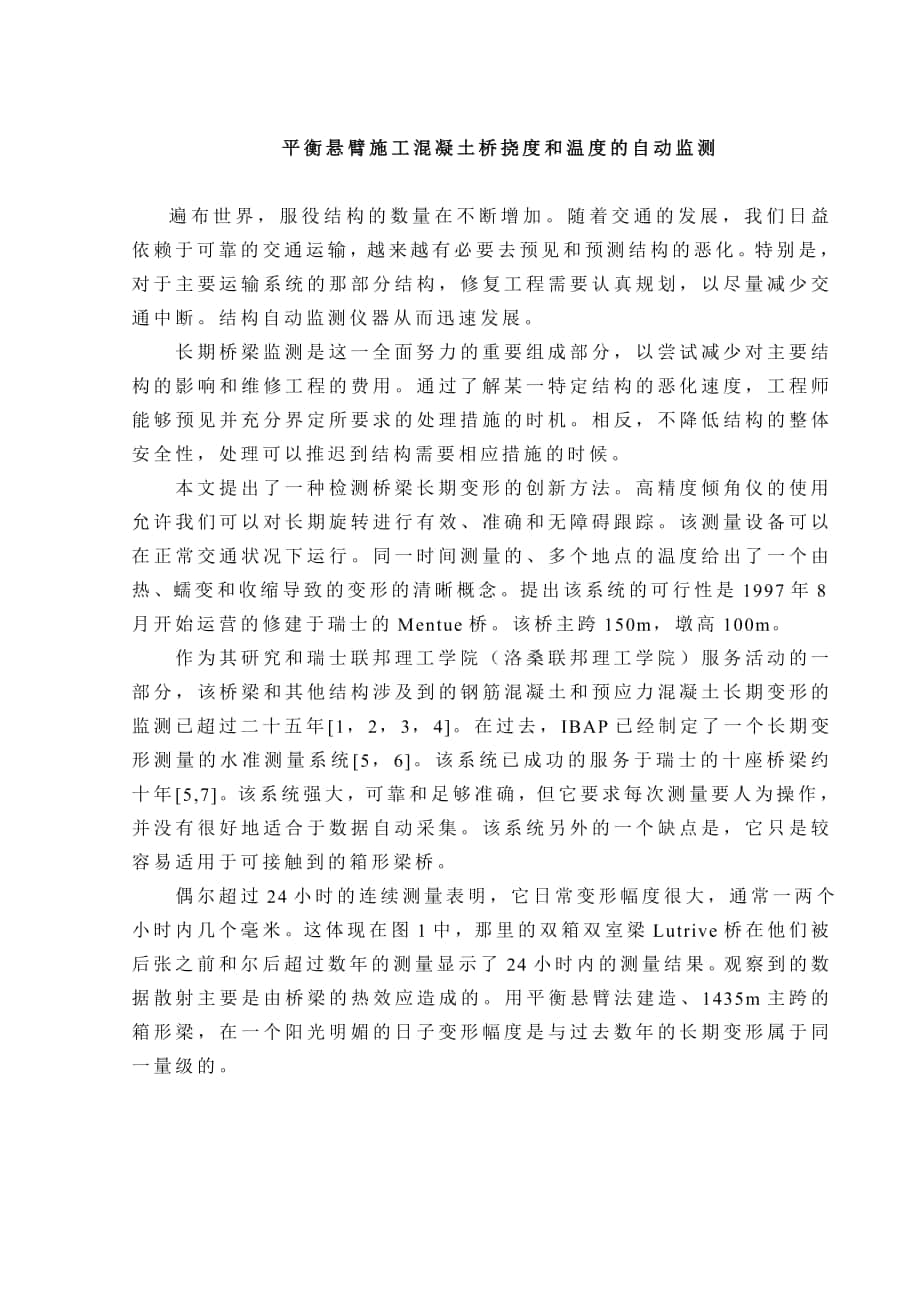 平衡悬臂施工混凝土桥挠度和温度的自动监测毕业论文外文翻译
平衡悬臂施工混凝土桥挠度和温度的自动监测毕业论文外文翻译



《平衡悬臂施工混凝土桥挠度和温度的自动监测毕业论文外文翻译》由会员分享,可在线阅读,更多相关《平衡悬臂施工混凝土桥挠度和温度的自动监测毕业论文外文翻译(6页珍藏版)》请在装配图网上搜索。
1、平衡悬臂施工混凝土桥挠度和温度的自动监测遍布世界,服役结构的数量在不断增加。随着交通的发展,我们日益依赖于可靠的交通运输,越来越有必要去预见和预测结构的恶化。特别是,对于主要运输系统的那部分结构,修复工程需要认真规划,以尽量减少交通中断。结构自动监测仪器从而迅速发展。 长期桥梁监测是这一全面努力的重要组成部分,以尝试减少对主要结构的影响和维修工程的费用。通过了解某一特定结构的恶化速度,工程师能够预见并充分界定所要求的处理措施的时机。相反,不降低结构的整体安全性,处理可以推迟到结构需要相应措施的时候。 本文提出了一种检测桥梁长期变形的创新方法。高精度倾角仪的使用允许我们可以对长期旋转进行有效、准
2、确和无障碍跟踪。该测量设备可以在正常交通状况下运行。同一时间测量的、多个地点的温度给出了一个由热、蠕变和收缩导致的变形的清晰概念。提出该系统的可行性是1997年8月开始运营的修建于瑞士的Mentue桥。该桥主跨150m,墩高100m。 作为其研究和瑞士联邦理工学院(洛桑联邦理工学院)服务活动的一部分,该桥梁和其他结构涉及到的钢筋混凝土和预应力混凝土长期变形的监测已超过二十五年1,2,3,4。在过去,IBAP已经制定了一个长期变形测量的水准测量系统5,6。该系统已成功的服务于瑞士的十座桥梁约十年5,7。该系统强大,可靠和足够准确,但它要求每次测量要人为操作,并没有很好地适合于数据自动采集。该系统
3、另外的一个缺点是,它只是较容易适用于可接触到的箱形梁桥。 偶尔超过24小时的连续测量表明,它日常变形幅度很大,通常一两个小时内几个毫米。这体现在图1中,那里的双箱双室梁Lutrive桥在他们被后张之前和尔后超过数年的测量显示了24小时内的测量结果。观察到的数据散射主要是由桥梁的热效应造成的。用平衡悬臂法建造、1435m主跨的箱形梁,在一个阳光明媚的日子变形幅度是与过去数年的长期变形属于同一量级的。瞬时测量,如水准测量得出的结果,不一定代表了该桥的平均位置。这是因为在桥梁测量时的位置是受过去几个小时、几天气温的温度历史影响。即使周全的考虑影响监测测量结果的因素并且在每年的同一时期进行测量,也需要
4、相对较长的时间,我们才能弄清楚Lutrive桥在1988年进行改造时额外桥梁后张3,7,11有没有产生与两者相同的影响。 图1:Lutrive桥的长期挠度,与24小时内挠度自动采集的数据,使得我们可以在一个可接受的成本上进行方便地测量,因此非常可取。一个可能的解决方案研究,进行了包括基于激光水准,光纤传感器和GPS定位,得出的结论是,只要可以确保它们的长期稳定性,当前类型的电子倾角仪,都适合于自动测量现有桥梁的旋转量8。 Mentue桥是单箱双室箱梁桥,将衔接从洛桑到伯尔尼的未来A1高速公路。每片梁设计类似,拥有约565m的,整体长度和宽度,设计承载两行车线和一个应急车道。平衡悬臂桥梁施工设计
5、是与另一桥梁方案比选的结果。100m高的混凝土桥墩用爬模施工方法完成后,平衡悬臂施工启动(图3) 。附录二AUTOMATIC DEFLECTION AND TEMPERATURE MONITORING OF All over the world, the number of structures in service keeps increasing. With the development of traffic and the increased dependence on reliable transportation, it is becoming more and more nece
6、ssary to foresee and anticipate the deterioration of structures. In particular, for structures that are part of major transportation systems, rehabilitation works need to be carefully planned in order to minimize disruptions of traffic. Automatic monitoring of structures is thus rapidly developing.L
7、ong-term monitoring of bridges is an important part of this overall effort to attempt to minimize both the impact and the cost of maintenance and rehabilitation work of major structures. By knowing the rate of deterioration of a given structure, the engineer is able to anticipate and adequately defi
8、ne the timing of required interventions. Conversely, interventions can be delayed until the condition of the structure requires them, without reducing the overall safety of the structure.The paper presents an innovative approach to the measurement of long-term bridge deformations. The use of high pr
9、ecision inclinometers permits an effective, accurate and unobtrusive following of the long-term rotations. The measurements can be performed under traffic conditions. Simultaneous measurement of the temperature at several locations gives a clear idea of the movements induced by thermal conditions an
10、d those induced by creep and shrinkage. The system presented is operational since August 1997 in the Mentue bridge, currently under construction in Switzerland. The structure has a main span of 150 m and piers 100 m high. As part of its research and service activities within the Swiss Federal Instit
11、ute of Technology in Lausanne (EPFL), IBAP - Reinforced and Prestressed Concrete has been involved in the monitoring of long-time deformations of bridges and other structures for over twenty-five years 1, 2, 3, 4. In the past, IBAP has developed a system for the measurement of long-term deformations
12、 using hydrostatic leveling 5, 6. This system has been in successful service in ten bridges in Switzerland for approximately ten years 5,7. The system is robust, reliable and sufficiently accurate, but it requires human intervention for each measurement, and is not well suited for automatic data acq
13、uisition. One additional disadvantage of this system is that it is only easily applicable to box girder bridges with an accessible box.Occasional continuous measurements over periods of 24 hours have shown that the amplitude of daily movements is significant, usually amounting to several millimeters
14、 over a couple of hours. This is exemplified in figure 1, where measurements of the twin Lutrive bridges, taken over a period of several years before and after they were strengthened by post-tensioning, are shown along with measurements performed over a period of 24 hours. The scatter observed in th
15、e data is primarily caused by thermal effects on the bridges. In the case of these box-girder bridges built by the balanced cantilever method, with a main span of 143.5 m, the amplitude of deformations on a sunny day is of the same order of magnitude than the long term deformation over several years
16、.Instantaneous measurements, as those made by hydrostatic leveling, are not necessarily representative of the mean position of the bridge. This occurs because the position of the bridge at the time of the measurement is influenced by the temperature history over the past several hours and days. Even
17、 if every care was taken to perform the measurements early in the morning and at the same period every year, it took a relatively long time before it was realized that the retrofit performed on the Lutrive bridges in 1988 by additional post-tensioning 3, 7,11 had not had the same effect on both of t
18、hem.Figure 1: Long-term deflections of the Lutrive bridges, compared to deflections measured in a 24-hour period Automatic data acquisition, allowing frequent measurements to be performed at an acceptable cost, is thus highly desirable. A study of possible solutions including laser-based leveling, f
19、iber optics sensors and GPS-positioning was performed, with the conclusion that, provided that their long-term stability can be demonstrated, current types of electronic inclinometers are suitable for automatic measurements of rotations in existing bridges 8.The Mentue bridges are twin box-girder br
20、idges that will carry the future A1 motorway from Lausanne to Bern. Each bridge, similar in design, has an overall length of approximately 565 m, and a width of 13.46 m, designed to carry two lanes of traffic and an emergency lane. The bridges cross a deep valley with steep sides (fig. 2). The balanced cantilever design results from a bridge competition. The 100 m high concrete piers were built using climbing formwork, after which the construction of the balanced cantilever started (fig. 3).
- 温馨提示:
1: 本站所有资源如无特殊说明,都需要本地电脑安装OFFICE2007和PDF阅读器。图纸软件为CAD,CAXA,PROE,UG,SolidWorks等.压缩文件请下载最新的WinRAR软件解压。
2: 本站的文档不包含任何第三方提供的附件图纸等,如果需要附件,请联系上传者。文件的所有权益归上传用户所有。
3.本站RAR压缩包中若带图纸,网页内容里面会有图纸预览,若没有图纸预览就没有图纸。
4. 未经权益所有人同意不得将文件中的内容挪作商业或盈利用途。
5. 装配图网仅提供信息存储空间,仅对用户上传内容的表现方式做保护处理,对用户上传分享的文档内容本身不做任何修改或编辑,并不能对任何下载内容负责。
6. 下载文件中如有侵权或不适当内容,请与我们联系,我们立即纠正。
7. 本站不保证下载资源的准确性、安全性和完整性, 同时也不承担用户因使用这些下载资源对自己和他人造成任何形式的伤害或损失。
